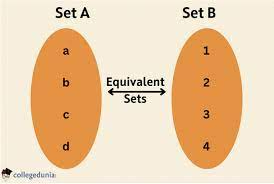Equivalence of Sets Exploration

Explanations with Examples
In mathematics, equivalence relations are a fundamental concept that arise in various fields, including set theory, abstract algebra, and graph theory. An equivalence relation on a set is a relation that satisfies three important properties: reflexive, symmetric, and transitive. Let's define each of these properties and explore their significance in the context of an equivalence relation on a set.
Consider a set "S" and an equivalence relation "R" on that set.
1. Reflexive Property:
The reflexive property states that every element in the set "S" is related to itself under the equivalence relation "R." In other words, for every element "a" in "S," (a, a) must be in "R."
Mathematically, the reflexive property is represented as:
∀a ∈ S, (a, a) ∈ R.
For example, if we have a set of integers S = {1, 2, 3}, and the equivalence relation "R" is defined as "having the same parity," then "R" is reflexive because every integer is related to itself with respect to its parity.
2. Symmetric Property:
The symmetric property states that if two elements "a" and "b" are related under the equivalence relation "R," then "b" must also be related to "a." In other words, if (a, b) is in "R," then (b, a) must also be in "R."
Mathematically, the symmetric property is represented as:
∀a, b ∈ S, if (a, b) ∈ R, then (b, a) ∈ R.
Using the same example of the equivalence relation "R" defined as "having the same parity," the symmetric property holds because if two integers have the same parity, then the reverse is also true.
3. Transitive Property:
The transitive property states that if two elements "a" and "b" are related, and "b" and "c" are related, then "a" and "c" must also be related under the equivalence relation "R."
Mathematically, the transitive property is represented as:
∀a, b, c ∈ S, if (a, b) ∈ R and (b, c) ∈ R, then (a, c) ∈ R.
In the example of the equivalence relation "R" defined as "having the same parity," the transitive property holds because if two integers have the same parity, and another pair of integers also have the same parity, then the first and third integers will have the same parity as well.
Putting it all together, if a relation "R" on a set "S" satisfies the reflexive, symmetric, and transitive properties, then "R" is an equivalence relation. Equivalence relations play a crucial role in partitioning sets into distinct equivalence classes, where elements within each class are related to each other but not to elements in other classes. This partitioning helps in structuring and understanding the properties of sets in various mathematical contexts.
What familiar equivalence relation is R?
Consider the partition P = {{. . . −4,−2,0,2,4, . . . }, {. . . ,−5,−3,−1,1,3,5, . . . }}of Z. Let R be the equivalence relation whose equivalence classes are the two elements of P. What familiar equivalence relation is R?